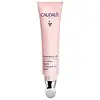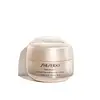What's inside
What's inside
 Key Ingredients
Key Ingredients

 Benefits
Benefits

 Concerns
Concerns

 Ingredients Side-by-side
Ingredients Side-by-side

Water
Skin ConditioningButylene Glycol
HumectantGlycerin
HumectantCoco-Caprylate/Caprate
EmollientIsoamyl Laurate
EmollientPolyacrylate Crosspolymer-6
Emulsion StabilisingEthylhexylglycerin
Skin ConditioningSodium Polyacrylate
AbsorbentPalmitoyl Grapevine Shoot Extract
AntioxidantSclerotium Gum
Emulsion StabilisingXanthan Gum
EmulsifyingChenopodium Quinoa Seed Extract
Skin ConditioningHelianthus Annuus Seed Oil
EmollientTocopherol
AntioxidantBenzyl Alcohol
PerfumingHydrolyzed Hyaluronic Acid
HumectantCaesalpinia Spinosa Fruit Extract
Skin ProtectingAdenosine
Skin ConditioningAcetyl Dipeptide-1 Cetyl Ester
Skin ConditioningSodium Phytate
Sodium Benzoate
MaskingKappaphycus Alvarezii Extract
Skin ConditioningHyaluronic Acid
HumectantPentylene Glycol
Skin ConditioningKhaya Senegalensis Bark Extract
Skin ProtectingMaltodextrin
AbsorbentPaeonia Lactiflora Root Extract
Skin ConditioningNicotiana Benthamiana Hexapeptide-40 Sh-Polypeptide-47
Skin ConditioningWater, Butylene Glycol, Glycerin, Coco-Caprylate/Caprate, Isoamyl Laurate, Polyacrylate Crosspolymer-6, Ethylhexylglycerin, Sodium Polyacrylate, Palmitoyl Grapevine Shoot Extract, Sclerotium Gum, Xanthan Gum, Chenopodium Quinoa Seed Extract, Helianthus Annuus Seed Oil, Tocopherol, Benzyl Alcohol, Hydrolyzed Hyaluronic Acid, Caesalpinia Spinosa Fruit Extract, Adenosine, Acetyl Dipeptide-1 Cetyl Ester, Sodium Phytate, Sodium Benzoate, Kappaphycus Alvarezii Extract, Hyaluronic Acid, Pentylene Glycol, Khaya Senegalensis Bark Extract, Maltodextrin, Paeonia Lactiflora Root Extract, Nicotiana Benthamiana Hexapeptide-40 Sh-Polypeptide-47
Water
Skin ConditioningHydrogenated Polydecene
EmollientGlycerin
HumectantParaffinum Liquidum
EmollientPetrolatum
EmollientButylene Glycol
HumectantParaffin
PerfumingPolyglyceryl-2 Diisostearate
EmulsifyingSqualane
EmollientGlyceryl Oleate
EmollientSodium PCA
HumectantGlutamic Acid
HumectantDipropylene Glycol
HumectantCarnosine
Skin ConditioningBeeswax
Emulsion StabilisingMicrocrystalline Wax
Emulsion StabilisingSodium Hydroxide
BufferingAlcohol
AntimicrobialPolyethylene
AbrasiveMethylparaben
PreservativeTocopheryl Acetate
AntioxidantEthylparaben
PreservativePhytosteryl/Octyldodecyl Lauroyl Glutamate
Skin ConditioningParfum
MaskingTrisodium EDTA
Tocopherol
AntioxidantSodium Metabisulfite
AntioxidantCaffeine
Skin ConditioningCI 77492
Cosmetic ColorantPEG/PPG-14/7 Dimethyl Ether
Skin ConditioningPPG-3 Dipivalate
Skin ConditioningLinalool
PerfumingLimonene
PerfumingSapindus Mukorossi Peel Extract
Skin ConditioningCitronellol
PerfumingUncaria Gambir Extract
AstringentGeraniol
PerfumingAngelica Keiskei Leaf/Stem Extract
Skin ConditioningAlpha-Isomethyl Ionone
PerfumingSanguisorba Officinalis Root Extract
CleansingCrataegus Monogyna Flower Extract
Skin ConditioningCamellia Sinensis Leaf Extract
AntimicrobialSodium Acetylated Hyaluronate
HumectantHydroxyproline
Skin ConditioningCI 77491
Cosmetic ColorantCitrus Junos Seed Extract
AntioxidantCinnamomum Cassia Bark Extract
MaskingZiziphus Jujuba Fruit Extract
Skin ConditioningChlorella Vulgaris Extract
Skin ConditioningEucheuma Serra/Grateloupia Sparsa/Saccharina Angustata/Ulva Linza/Undaria Pinnatifida Extract
EmollientCarbomer
Emulsion StabilisingSodium Lactate
BufferingBHT
AntioxidantCurcuma Longa Rhizome Extract
Skin ConditioningPolysorbate 20
EmulsifyingSaccharina Angustata/Undaria Pinnatifida Extract
EmollientPalmitoyl Tripeptide-1
Skin ConditioningPalmitoyl Tetrapeptide-7
Skin ConditioningWater, Hydrogenated Polydecene, Glycerin, Paraffinum Liquidum, Petrolatum, Butylene Glycol, Paraffin, Polyglyceryl-2 Diisostearate, Squalane, Glyceryl Oleate, Sodium PCA, Glutamic Acid, Dipropylene Glycol, Carnosine, Beeswax, Microcrystalline Wax, Sodium Hydroxide, Alcohol, Polyethylene, Methylparaben, Tocopheryl Acetate, Ethylparaben, Phytosteryl/Octyldodecyl Lauroyl Glutamate, Parfum, Trisodium EDTA, Tocopherol, Sodium Metabisulfite, Caffeine, CI 77492, PEG/PPG-14/7 Dimethyl Ether, PPG-3 Dipivalate, Linalool, Limonene, Sapindus Mukorossi Peel Extract, Citronellol, Uncaria Gambir Extract, Geraniol, Angelica Keiskei Leaf/Stem Extract, Alpha-Isomethyl Ionone, Sanguisorba Officinalis Root Extract, Crataegus Monogyna Flower Extract, Camellia Sinensis Leaf Extract, Sodium Acetylated Hyaluronate, Hydroxyproline, CI 77491, Citrus Junos Seed Extract, Cinnamomum Cassia Bark Extract, Ziziphus Jujuba Fruit Extract, Chlorella Vulgaris Extract, Eucheuma Serra/Grateloupia Sparsa/Saccharina Angustata/Ulva Linza/Undaria Pinnatifida Extract, Carbomer, Sodium Lactate, BHT, Curcuma Longa Rhizome Extract, Polysorbate 20, Saccharina Angustata/Undaria Pinnatifida Extract, Palmitoyl Tripeptide-1, Palmitoyl Tetrapeptide-7
 Reviews
Reviews

Ingredients Explained
These ingredients are found in both products.
Ingredients higher up in an ingredient list are typically present in a larger amount.
Butylene Glycol (or BG) is used within cosmetic products for a few different reasons:
Overall, Butylene Glycol is a safe and well-rounded ingredient that works well with other ingredients.
Though this ingredient works well with most skin types, some people with sensitive skin may experience a reaction such as allergic rashes, closed comedones, or itchiness.
Learn more about Butylene GlycolGlycerin is already naturally found in your skin. It helps moisturize and protect your skin.
A study from 2016 found glycerin to be more effective as a humectant than AHAs and hyaluronic acid.
As a humectant, it helps the skin stay hydrated by pulling moisture to your skin. The low molecular weight of glycerin allows it to pull moisture into the deeper layers of your skin.
Hydrated skin improves your skin barrier; Your skin barrier helps protect against irritants and bacteria.
Glycerin has also been found to have antimicrobial and antiviral properties. Due to these properties, glycerin is often used in wound and burn treatments.
In cosmetics, glycerin is usually derived from plants such as soybean or palm. However, it can also be sourced from animals, such as tallow or animal fat.
This ingredient is organic, colorless, odorless, and non-toxic.
Glycerin is the name for this ingredient in American English. British English uses Glycerol/Glycerine.
Learn more about GlycerinTocopherol (also known as Vitamin E) is a common antioxidant used to help protect the skin from free-radicals and strengthen the skin barrier. It's also fat soluble - this means our skin is great at absorbing it.
Vitamin E also helps keep your natural skin lipids healthy. Your lipid skin barrier naturally consists of lipids, ceramides, and fatty acids. Vitamin E offers extra protection for your skin’s lipid barrier, keeping your skin healthy and nourished.
Another benefit is a bit of UV protection. Vitamin E helps reduce the damage caused by UVB rays. (It should not replace your sunscreen). Combining it with Vitamin C can decrease sunburned cells and hyperpigmentation after UV exposure.
You might have noticed Vitamin E + C often paired together. This is because it is great at stabilizing Vitamin C. Using the two together helps increase the effectiveness of both ingredients.
There are often claims that Vitamin E can reduce/prevent scarring, but these claims haven't been confirmed by scientific research.
Learn more about TocopherolWater. It's the most common cosmetic ingredient of all. You'll usually see it at the top of ingredient lists, meaning that it makes up the largest part of the product.
So why is it so popular? Water most often acts as a solvent - this means that it helps dissolve other ingredients into the formulation.
You'll also recognize water as that liquid we all need to stay alive. If you see this, drink a glass of water. Stay hydrated!
Learn more about Water